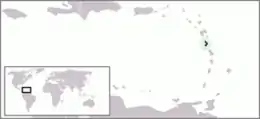Invasion of Dominica (1761)
The Invasion of Dominica was a British military expedition to capture the Caribbean island of Dominica in June 1761, as part of the Seven Years' War.
| Invasion of Dominica | |||||||
|---|---|---|---|---|---|---|---|
| Part of the Seven Years' War | |||||||
 Location of Dominica | |||||||
| |||||||
| Belligerents | |||||||
|
|
| ||||||
| Commanders and leaders | |||||||
|
Lord Rollo Sir James Douglas | Louis Robert de la Touche de Longpré (POW) | ||||||
| Strength | |||||||
|
4 ships of the line 2 frigates | unknown | ||||||
| Casualties and losses | |||||||
| 8 killed or wounded[1] | unknown | ||||||
Prelude
By the end of 1760, the conquest of Canada was completed and a great number of British troops were left idle in North America.
As early as January 1761, William Pitt had informed Amherst that some of his troops would be required in the autumn for the conquest of Dominica, Saint Lucia and Martinique. Amherst had to immediately send 2,000 men to Guadeloupe, which was already in British hands since the British expedition against Guadeloupe in 1759, where he would concert with the governor of the island the means of taking Dominica and Saint Lucia. Furthermore, Amherst had to despatch another 6,000 men later in the year for the capture of Martinique.
Expedition
In the first days of June 1761, transports from America began to drop singly into Guadeloupe, the fleet having been dispersed by a storm. By June 3, four ships had arrived, together with Lord Rollo, who had been appointed by Amherst to take the command.
On June 4, the whole of these British ships, together with one ship more from Guadeloupe itself, made sail under escort of the squadron of Sir James Douglas, the admiral on the Leeward Islands station, to beat back against the trade wind to Dominica. The force consisted of:
- a detachment from the garrison of Guadeloupe (300 men)
- Highlanders (400 men)
- 22nd Regiment of Foot
- 94th Vaughan's Regiment of Foot
On June 6 by noon, the British force had arrived before Roseau, where the inhabitants were summoned to surrender. The French replied by manning their batteries and other defences, which included four separate lines of entrenchments, ranged one above another. Rollo landed his men and entered the town. Fearing that the French might be reinforced in the night, he resolved, though it was already late, to storm the entrenchments immediately. He attacked and drove out the French in confusion with trifling loss to himself. The French commander and his second were both taken prisoners. After this engagement, resistance ceased.
On June 7, Dominica swore allegiance to King George.
Aftermath
Unlike Guadeloupe and Martinique, the island was not given back to France after the 1763 Treaty of Paris. The island was captured and held by France during the American War of Independence between 1778 and 1783, after which it was returned to British control. It remained in British hands until its independence in 1978.
References
- Marley, p. 288
Sources
- Fortescue, J. W.; A History of the British Army Vol. II, MacMillan, London, 1899, pp. 537–538.
- British expedition against Dominica
- Wars of the Americas: A Chronology, David Marley